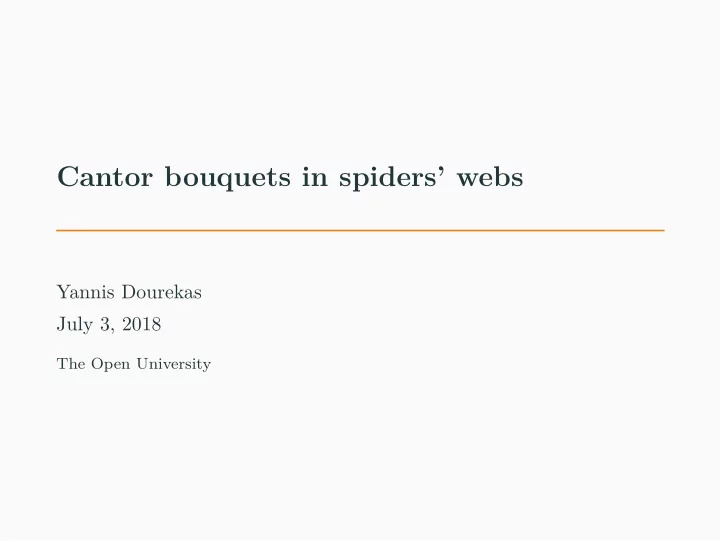

Cantor bouquets in spiders’ webs Yannis Dourekas July 3, 2018 The Open University
Basic defjnitions neighbourhood where the family of iterates is equicontinuous. infjnity under iteration. Let f : C → C be a transcendental entire function. The Fatou set , F ( f ) , is the set of points for which there is a The Julia set , J ( f ) , is the complement of the Fatou set. The escaping set , I ( f ) , is the set of points that tend to
Spiders’ webs Defjnition Examples of functions of regular growth whose escaping sets (and many of their Julia sets) are spiders’ webs (Rippon & Stallard 2012): • functions of fjnite order with Fabry gaps; and • many functions exhibiting the pits efgect. A set E ⊂ C is called a spider’s web if it is connected and there exists a sequence of bounded simply connected domains G n with G n ⊂ G n +1 for n ∈ N , ∂G n ⊂ E for n ∈ N , and ∪ n ∈ N G n = C . • functions of order ρ < 1 / 2 , with log log max | z | = r | f ( z ) | ρ = lim sup ; log r r →∞
Cantor bouquets Defjnition Roughly speaking, the Cartesian product of a Cantor set with called the endpoints , with each the curves being called a hair . Examples of functions that admit Cantor bouquets in their Julia sets: Tangerman 1986); • certain functions with a bounded set of critical and asymptotic values, i.e. in the Eremenko-Lyubich class, (e.g. Barański, Jarque, Rempe 2011); and Hubbard 1999). the closed half-line [0 , ∞ ) . The points in the Cantor set are • λe z for 0 < λ < 1 /e , µ sin z for 0 < µ < 1 (Devaney & • λe z , λ ∈ C ∗ (Bodelón, Devaney, Hayes, Roberts, Goldberg,
Cantor bouquets and spiders’ webs Part of the escaping set of A Cantor bouquet. Part of the escaping set of A spider’s web. z �→ 1 z �→ 1 4 e z . 2(cos z 1 / 4 + cosh z 1 / 4 ) .
repelling. bouquet, consisting of uncountably many, pairwise disjoint curves. The case λe z for 0 < λ < 1 /e Let E ( z ) = λe z for some 0 < λ < 1 /e . • E has two fjxed points; 0 < q < 1 is attracting and p > 1 is • All points z with Re < p lie in the basin of attraction of q , which is open and dense in C . • J ( E ) is the complement of this basin and a Cantor
each point in this curve shares the same address. We can locate a Cantor bouquet in this case as follows. The case λe z for 0 < λ < 1 /e • For fjxed N ∈ N , defjne 2 N + 1 horizontal half-strips of width 2 π in the right half-plane; { T k : k = − N, . . . , N } . • Let Λ N be the set of points that stay in ∪ | k |≤ N T k under iteration. The sequence of integers s = s 0 s 1 . . . defjned by E n ( z ) ∈ T s n is called the address of z ∈ Λ N . • To each address with | s j | ≤ N for all j ∈ N , there corresponds a unique curve in Λ N with the property that
Cantor bouquets in a spider’s web Theorem We prove the following: area. Theorem (Sixsmith 2015) We defjne the family of transcendental entire functions n − 1 { )} ( ∑ ω k E = ∪ n ≥ 3 f : f ( z ) = exp n z , k =0 where ω n = exp(2 πi/n ) is an n th root of unity. Let f ∈ E . Then I ( f ) and J ( f ) are spiders’ webs of positive Let f ∈ E . Then there exist Cantor bouquets inside J ( f ) .
and Curves are in the Julia set Lemma (Sixsmith 2015) Suppose that f is a transcendental entire function and that z 0 ∈ I ( f ) . Set z n = f n ( z 0 ) , for n ∈ N . Suppose that there exist λ > 1 and N ≥ 0 such that f ′ ( z n ) � � � � f ( z n ) ̸ = 0 � z n � ≥ λ, for n ≥ N. � � f ( z n ) Then either z 0 is in a multiply connected Fatou component of f , or z 0 ∈ J ( f ) .
Recommend
More recommend